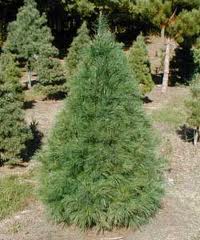Pines, Cypress, and Cedars
 Question from Gina:
Question from Gina:
I’ve loved your books since I first started gardening!
I would like to plant a large hillside in Topanga, Malibu CA with ‘christmas trees’. What pines/cypresss/cedars will work in this area and not get too giant. Are there dwarf specimens that will give that christmas tree look.
The garden is high up on a hill with intense heat in the summer and ‘sometimes’ frost in the winter. The hillside is North facing.
Thank you so much!!!!
Answer from Pat:
I once lived in Malibu, near the foot of Topanga Canyon, so have some familiarity with that area. Thank you for loving my books.
Your question leaves me wondering, do you plan to go into the cut-and-carry Christmas tree business? Or, alternatively, are you speaking descriptively of the look you want to achieve? I decided this must be it. You want the look of a Christmas tree, but you are willing to plant any conifer that will fulfill that feeling.
The first thing to consider is your climate zone. Since it’s hot in summer and sometimes freezes in winter, you must be higher up, not right on the coast. I am guessing that you are in Sunset Zone 23. Whatever trees you choose to plant must be adapted to Sunset Zone 23. Also, north-facing slopes are cooler and shadier than south-facing so I am thinking if it gets that hot in summer your property is up high overlooking the sea. I once knew a place like that that got very hot in summer and it even had an ocean view. It was north-facing and high up in Palos Verdes, but I again this is just a guess.
The pine trees that are adapted to your location are many, but one possibility is shore pine or beach pine (Pinus contorta), but it doesn’t fill all your requirements. It grows quickly in the shape of a Christmas tree to 20 or 35 feet and then it loses the Christmas tree shape and develops an irregular shape with a broad head. Also it must have regular water. However, ocean wind can dwarf it and it takes well to pruning so it’s worth consideration. Another possibility is Afghan pine (P. elderica). I planted one as a seedling years ago and it grew in Christmas tree shape for 20 years but then side branches grew too long and lanky in our climate, so I don’t recommend it. Canary Island pine (P. canariensis) is one of the better pines for Southern California but not really a Christmas tree. Coulter pine is a good one since it is adapted to dry rocky slopes and more disease and pest resistant than most, but does not have a true Christmas tree shape. If you can give up that shape this is one of your top choices. Aleppo pine is also a good cholce for our climate, but again has the wrong shape. I suggest that you look into Japanese white pine (P. parviflora) This will give you the pyramidical form you are looking for at least for 20 years but then will make a head. These are breathtakingly beautiful in age, and there are even dwarf varieties so look into this one. You must water it regularly however. If I were you I would study the pages on pine trees in “Sunset Western Garden Book” before making any decision.
There are a number of other conifers you might consider. Among cypress: Cupressus Arizonica ‘Blue Pyramid’, but it does get beetles, borers and diseases at least in interior zones. Among cedars, Cedar of Lebanon (C. lebani) is an idea. It is a dense pyramid in youth but eventually becomes a huge and gloriously handsome spreading tree. But this one may be difficult to come by and somewhat expensive. You could begin with small ones but give them space to grow. This becomes very large in age and this too would be breathtakingly handsome if you continued to live there for as long as 50 or 75 years and could eventually see it in age.
Beyond that, I would caution you to give long and serious consideration before taking this step. Do you really want to cover a whole hillside with such combustible trees? Pines, cypress, and cedar trees are among the trees that burn most quickly in a wildfire due to their resinous sap. Cedar trees particularly (but any of them) can literally explode in a hot fire. I was once in a forest fire and saw pine trees explode. It is a pretty scary sight. Could there not be some other solution to your bank? Malibu has been subject to wildfires before and it could happen again, especially when strong Santa Ana winds sweep through that area in fall. We seem to be in an era of increasing weather swings and summer heat. Also, there are water restrictions to consider. The best way to keep conifers free from diseases is to water them especially in late summer and in some cases even to fertilize them. Additionally whenever one creates a plantation of one plant species it becomes a perfect haven for pests such as beetles and borers, which afflict many conifers. Whatever you do, for example, don’t plant Monterey pines or Monterey cypress. They are particularly prone to being attacked and killed by beetles and fungus.

